What Really Happened in the Garden of Eden?
We all know the story of the Garden of Eden. God created Adam, then Eve, and he told the two not to eat fruit from a certain tree. But the snake tempted Eve to taste the forbidden fruit; she, in turn, seduced Adam to do the same, and this led to their Fall. All of this is self-evident and obvious from reading the Bible—or is it? In What Really Happened in the Garden of Eden?, Ziony Zevit examines the story closely to elucidate what it likely meant in its original context. He argues that much of what people believe about the story now is actually based on misconstruals of the story’s language, and incorrect interpretations of the events. Here are some of the fascinating points that Zevit puts forth in his book:
Adam was not made from dust
The first human was not made from dust or loose earth, as is commonly believed, but from a clod of soil. Zevit explains that the word used, āpār, means ‘a clod of soil’, “something people can handle, wrap their fingers around, squeeze and shape, like a mud ball.” He refers to evidence from the Psalms as well as Mesopotamian traditions to show that the Israelites believed that a clod provided the necessary critical mass of inert substance into which “personality” could be infused. Zevit explains, “God molded a wetted clod, a malleable clump of soil, into the shape that he desired and animated it by infusing his breath.”
Eve was not made from Adam’s rib
According to the text of the Book of Genesis, God formed Eve from Adam’s ṣela’. This word has almost always been translated to mean ‘rib’, but there is ample reason to re-examine this, Zevit asserts. Zevit refers to historical rabbinic interpretations to show that the word could refer to Adam’s tail; this reading would correspond with the biological facts, namely, man’s lack of tail in comparison to other vertebrate mammals (whereas males do not have one rib less than females). Zevit then goes on to propose his own hypothesis: ṣela’ could be associated with the penis, specifically given the seam on the external genitalia of males.
Adam was not seduced by Eve to eat the fruit
What the text actually says about Adam and Eve’s consumption of the fruit is this: the woman “took from its fruit and ate and she gave also to her man, who was with her, and he ate” (Gen 3:6). There is nothing in the narrative to suggest that Adam was tempted; his action was abrupt and instinctive. As Zavit describes, it was simply the case that “Given fruit, Adam ate. Like an infant being spoonfed, asking no questions, he opened his mouth, chomped, chewed, and swallowed.”
Zavit’s analysis of the story of the Garden of Eden is incisive and thoroughly researched, and it overturns many long-held assumptions about the text. Drawing on such diverse disciplines as biblical studies, geography, archaeology, mythology, anthropology, biology, poetics, law, linguistics, and literary theory, he clarifies the worldview of the ancient Israelite readers to show us what the story really meant at the time. This ambitious book unsettles much of what has been taken for granted for over two millennia and has far-reaching implications for both literary and theological interpreters.





